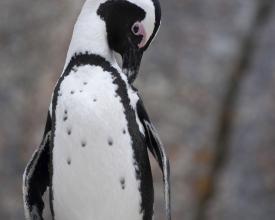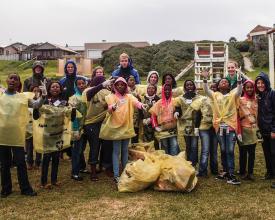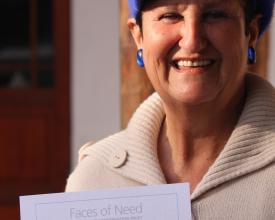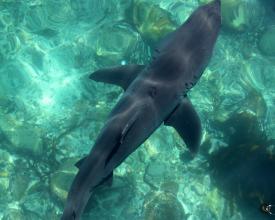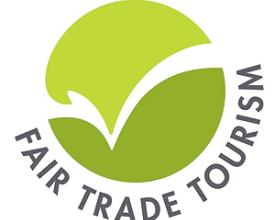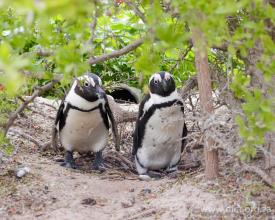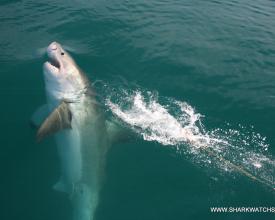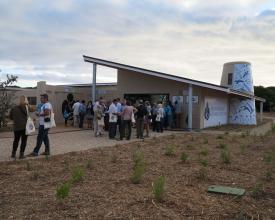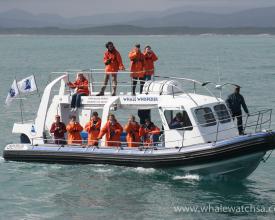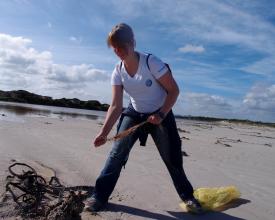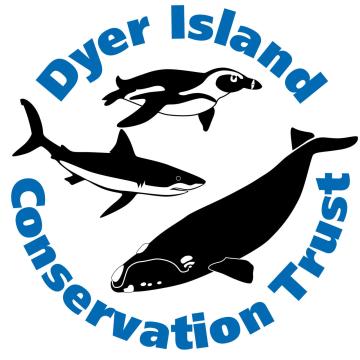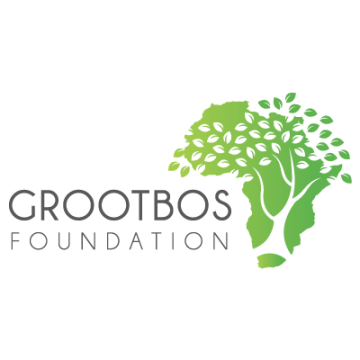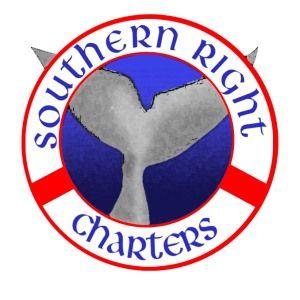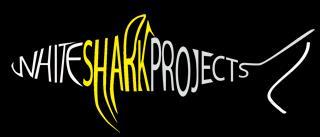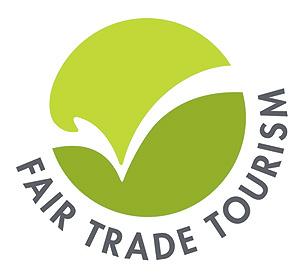
Développement d'une grappe d'entreprises de tourisme marin et côtier responsable
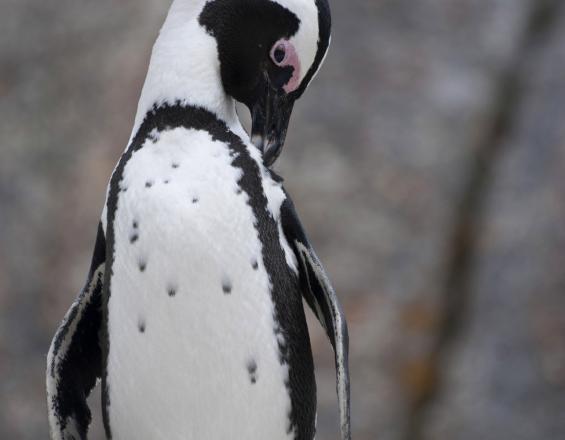
Le tourisme équitable (FTT) et le Dyer Island Conservation Trust (DICT) ont uni leurs forces pour s'assurer que les personnes qui contribuent au tourisme par leurs terres, leurs ressources côtières et marines, leur travail et leurs connaissances sont celles qui en récoltent les fruits. En collaboration avec les entreprises, la société civile et les autorités locales de la côte des baleines du Cap (Afrique du Sud), le DICT sensibilise les voyageurs à la protection de l'environnement marin dans les petites villes de la côte que sont Hermanus, Stanford, Gansbaai et Kleinmond.
Contexte
Défis à relever
Pression exercée par le développement sur les espèces clés et les habitats côtiers fragiles :
- Braconnage des requins (pour les ailerons et les mâchoires)
- Développement résidentiel sur le littoral
- Le développement du site nucléaire risque d'augmenter la température de l'eau et de modifier le comportement des requins et d'autres espèces.
Absence de moyens de subsistance durables et de sensibilisation à l'environnement au sein de la population locale
Emplacement
Traiter
Résumé du processus
Au sein de la destination Cape Whale Coast, Fair Trade Tourism (FTT) a travaillé avec un certain nombre d'entreprises au cours des dix dernières années. À ce jour, sept d'entre elles ont été certifiées : Grootbos Private Game Reserve, Farm 215, Whalesong Lodge, Dyer Island Cruises, Marine Dynamics, White Shark Projects et Southern Right Charters. Depuis la fin des années 1990, ces entreprises et leurs partenaires des autorités publiques et de la société civile ont développé organiquement un réseau d'initiatives et d'organisations qui ont fourni un exemple exceptionnel de développement touristique responsable dans une destination côtière et marine. Bien que le leadership en matière de développement touristique durable dont ces chefs d'entreprise ont fait preuve au cours des dernières années soit indépendant et n'ait à l'origine aucun lien avec la certification FTT, les éléments constitutifs des services de la FTT aident à structurer et à renforcer les résultats de ces bonnes pratiques en fonction de l'ensemble des critères de son système de gestion de la qualité. La FTT promeut les exemples de bonnes pratiques comme des solutions pour le développement d'un tourisme responsable dans les destinations côtières d'autres pays. Il fournit les outils pour appliquer et reproduire les leçons apprises dans d'autres destinations de la région d'Afrique australe.
Blocs de construction
Certification, soutien au développement des entreprises et des marchés
Facteurs favorables
Leçon apprise
Collaboration public-privé pour la conservation
Facteurs favorables
Leçon apprise
Conservation des espèces phares
Facteurs favorables
Leçon apprise
Ressources
Programme de récupération des lignes de pêche et drapeau bleu
Facteurs favorables
Leçon apprise
Restauration des écosystèmes et éducation à l'environnement
Facteurs favorables
Leçon apprise
Ressources
Impacts
Ensemble, les entreprises certifiées par le tourisme équitable dans la région de Cape Whale Coast emploient de nombreux hommes et femmes dans des emplois décents, tout en ayant un impact positif sur leurs communautés d'accueil, leur culture, leurs moyens de subsistance et leur développement économique. Grâce aux avantages économiques tangibles découlant du tourisme, une partie importante de la flore côtière du Fynbos est préservée. Les revenus générés par le tourisme et les dons versés par les touristes financent la protection de l'un des derniers habitats du manchot africain, une espèce menacée. Les revenus du tourisme permettent également d'effectuer des recherches sur un écosystème marin très fréquenté par plusieurs espèces de requins, de baleines et d'oiseaux marins. Le tourisme équitable et la certification Pavillon bleu garantissent que les navires d'observation des baleines et des requins sont exploités conformément à des normes internationales visant à minimiser les dommages causés à la biodiversité marine et à l'écosystème marin dans lequel ils opèrent. L'ensemble de l'éthique des entreprises est basé sur la conservation et la protection de l'environnement et la conviction que "Votre choix fait la différence", encourageant les touristes à faire des choix judicieux.
Bénéficiaires
Les travailleurs, les fournisseurs et les familles des entreprises certifiées ainsi que les communautés locales.
Histoire
Les réalisations actuelles du Dyer Island Conservation Trust (DICT) auraient été impossibles sans Wilfred Chivell, le visionnaire à l'origine des entreprises prospères Dyer Island Cruises et Marine Dynamics. Lorsque la crise financière sud-africaine de 1998 a détruit les cinq entreprises de béton que Wilfred possédait à l'époque, il a non seulement décidé de faire de sa passion pour la vie marine une profession, mais aussi de réinvestir dans la conservation tout ce que sa nouvelle entreprise lui permettrait de faire. En 1999, il a créé une société d'observation des baleines, Dyer Island Cruises, avec un simple canot pneumatique. Il a ensuite acheté une société de plongée en cage avec des requins en 2005, Marine Dynamics, et a depuis changé beaucoup de choses dans un secteur qui pourrait être utilisé uniquement à des fins financières. Enfin, l'intérêt de Wilfred pour la nature, et en particulier pour le manchot africain en déclin rapide, l'a amené à fonder la DICT en 2006. Il a créé le projet d'hébergement "Faces of Need" pour cet oiseau vulnérable et incapable de voler et a organisé deux conférences sur les manchots, afin de faire pression pour que le manchot africain soit inscrit sur la liste des espèces menacées et de mobiliser des fonds pour sa protection. Peu de temps après, il s'est également assuré que ses deux entreprises remplissaient les conditions requises pour obtenir la certification "commerce équitable". Wilfred est en train de changer la façon dont l'industrie de la plongée en cage avec les requins est perçue et bénéficie du soutien d'autres organisations de protection de la nature. Il a structuré un modèle d'entreprise qui non seulement crée de l'emploi, mais bénéficie également à l'environnement et vise à protéger le patrimoine marin. Chaque jour, des fonds sont collectés auprès des clients qui visitent les entreprises, ce qui permet de soutenir le travail du Trust. Les entreprises de Wilfred soutiennent le Trust de diverses manières, en contribuant finalement à hauteur de 1 million d'euros à la recherche et à la conservation - trois biologistes marins ont été aidés à terminer leur master. Marine Dynamics a également lancé un programme international de bénévolat en mer qui permet aux participants d'en apprendre davantage sur le grand requin blanc et d'autres espèces grâce à une série de conférences spécialisées. Ces étudiants deviennent des ambassadeurs du grand requin blanc lorsqu'ils partent et plus il y a de personnes qui changent la perception de ce prédateur mal compris, meilleures sont ses chances de survie future. Avec son partenaire, Michael Lutzeyer, propriétaire de Grootbos et fondateur de la Fondation Grootbos, DICT et la Fondation Grootbos sont à la pointe de la recherche et de la conservation de la biodiversité marine et de l'écosystème côtier de Fynbos le long de la côte des baleines du Cap.

